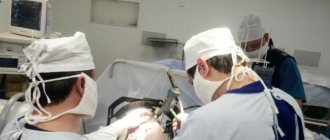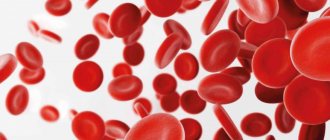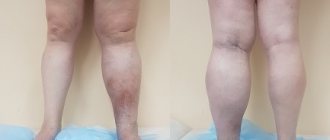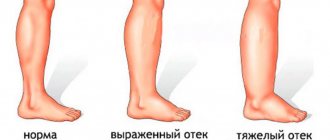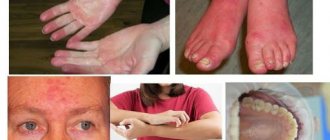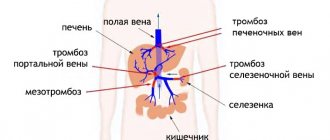Erythremia is a tumor clonal disease of the hematopoietic system, in which there is proliferation of erythroid, granulocytic and megakaryocytic lineages of hematopoiesis with predominant activation of erythropoiesis. At the same time, an increase in the level of red blood cells and hemoglobin, thrombocytosis and leukocytosis is noted in the blood. Almost all patients with erythremia are carriers of the JAK2V617F mutation.
- How does erythremia develop?
- Symptoms of erythremia
- Stages of erythremia
- Diagnosis of erythremia
- Treatment of erythremia
- Prognosis for erythremia
How does erythremia develop?
The causes of erythremia are still unknown. It is believed that this is a multi-stage disease in which, under the influence of external factors, the genome of a normal cell is damaged, which leads to its malignant transformation and the formation of a tumor cell clone that replaces normal hematopoiesis.
Almost all patients have a mutation in the JAK2 gene. Exon 14 is usually affected; 90-96% of patients have the V617F mutation. 2% of patients have mutations in exon 12. Damage to other genes, in particular MPL, CALR, is very rarely detected. All of these genetic pathologies are specific to erythremia, so their determination is necessary to confirm the diagnosis.
So, molecular genetic disorders cause activation of the JAK-STAT signaling pathway, which leads to increased proliferation of hematopoietic sprouts and an increase in the number of blood cells.
Monocytes and megakaryocytes (platelet precursors) produce a variety of cytokines - biologically active molecules that stimulate fibrotic changes, the formation of new blood vessels, which ultimately leads to osteosclerosis and bone marrow fibrosis. In addition, massive production of cytokines contributes to the development of tumor intoxication, which aggravates the general condition of patients.
There is also a disruption in the connection of stem cells with the microenvironment. This provokes the formation of foci of hematopoiesis outside the bone marrow. The liver and spleen are primarily affected.
What happens to the body
When the disease occurs, there is a danger of hypoxia, when body tissues do not receive enough oxygen. Even with excellent immunity, the patient needs treatment. The body cannot cope with the disease on its own:
- problems arise with the liver and spleen;
- blood pressure increases;
- the proper functioning of the kidneys is disrupted.
Note! Elderly people are at risk. Most often, according to statistics, these are men.
If younger people or children get sick, they suffer much more severely. The causes of the disease lie in the genetic predisposition of people. Vaquez-Osler disease is named after the Frenchman Louis Henry Vaquez and the Canadian William Osler, doctors who first described the disease in the late 19th and early 20th centuries.
Symptoms of erythremia
Clinically, erythremia manifests itself in two syndromes:
- Plethora (plethora). This syndrome is characterized by an increase in the number of circulating red blood cells. Symptomatically manifested by headaches, dizziness, attacks of rapid heartbeat, itchy skin and visual disturbances. The skin and mucous membranes have a bluish tint. Vascular complications are also possible: thrombosis, erythromelalgia (redness of the fingers, pain and burning sensation in them).
- Myeloproliferative syndrome - develops as a result of hyperplasia of hematopoietic germs. Symptomatically manifested by weakness, fever, sweating, itchy skin, bone pain. With the breakdown of granulocytes, a disturbance in urate metabolism is observed, which leads to the development of gout, kidney stones and urate diathesis.
Leading Israeli oncologists
- Professor Aron Sulkes
Oncologist - Professor Moshe Inbar
Oncologist
- Professor Ofer Merimsky
Specialist in the treatment of sarcomas
- Dr. Yair Bar
Oncologist
Depending on in which vessels thrombosis occurs, a clinical picture of acute abdomen, gangrene of the lower or upper extremities, pulmonary artery thrombosis with hemoptysis, myocardial infarction, or cerebral stroke may develop.
“Like any other leukemia, erythremia is characterized by the development of secondary gout, accompanied by the development of urolithiasis and arthritis with severe pain, most often affecting the big toe joint.”
Stages of erythremia
During its development, erythremia goes through several stages. The first, also known as initial, can last more than 5 years. During this period, moderate manifestations of plethoral syndrome are mainly present. The blood test shows moderate erythrocytosis, and in the bone marrow there is an increase in the proliferation of all hematopoietic lineages with the exception of the lymphocytic lineage. The spleen is not enlarged, complications rarely develop.
The second stage of erythremia is polycythemia. It is divided into 2 substages A and B. Stage A lasts 5-15 years. It is characterized by an increase in the number of formed elements in the blood. As a result, a pronounced plethoric syndrome is formed, which is complicated by thrombosis, bleeding, and an increase in the size of the liver and spleen. In the blood test, cytosis increases; in the bone marrow, in addition to the proliferation of erythropoietic, granulocytic and thrombopoietic lineages, cicatricial changes are noted.
With erythremia in stage B, cytosis and clinical symptoms continue to increase. Foci of tumor growth form in the spleen, and cicatricial changes progress in the bone marrow.
Stage 3 of erythremia - anemic. Here, bone marrow fibrosis already develops, which leads to its depletion and a decrease in the level of blood cells. The disease can transform into acute leukemia.
Is this disease cancer?
Many patients, having heard that the pathology belongs to the category of leukemia, begin to panic and associate it with blood cancer. However, this assumption is not entirely correct. First of all, it is worth mentioning the malignant and benign nature of such formation. As a rule, when we talk about cancer, then in this case doctors talk about a tumor, which consists of epithelial tissue. However, polycythemia (Vaquez disease) is a formation consisting of hematopoietic tissue. Nevertheless, this disease can still be classified as malignant tumors.
However, it must be taken into account that such a pathology is characterized by high cell differentiation. In this case, there is a strong difference from cancer. The fact is that this disease can remain in a chronic stage for a very long time. This means that the tumor is classified as benign. If Vaquez's disease is treated in a timely manner, then there is every chance of a complete recovery.
If we allow the last stage of development of the disease, then in this case we will talk about a real malignant tumor. Therefore, it is better not to take risks.
Diagnosis of erythremia
As part of the diagnosis of erythremia, the patient undergoes a comprehensive examination, which includes the following measures:
- Anamnesis and physical examination, during which the color of the skin of the face and extremities is assessed. The size of the liver and spleen must be determined.
- A detailed blood test, including counting the number of blood cells and erythrocyte indices.
- Trephine biopsy of the bone marrow followed by histological and histochemical examination.
- Determination of erythropoietin level.
- Molecular genetic testing for the presence of specific V617F mutations.
- Ultrasound of the liver and spleen to accurately determine their size.
The diagnosis of erythremia is made according to the 2021 WHO criteria, which distinguishes three major criteria and one minor one.
Major criteria for erythremia:
- The hemoglobin level is more than 160 g/l in women and more than 165 g/l in men.
- Hyperplasia of three myelopoiesis lineages in bone marrow trephine.
- The presence of a mutation in the JAK2 gene.
A minor criterion is a decrease in erythropoietin levels.
To make a diagnosis of erythremia, it is necessary either to have all three major criteria, or 1-2 major and one minor.
Forecast
If we are talking about this pathology, then we should not immediately draw an analogy with cancerous tumors. Wekes disease is highly treatable. However, therapeutic measures should not be taken at the last stage of the disease. The good news is that the disease takes a very long time to develop. During this time, a person is guaranteed to be examined by a doctor at least once, who will pay attention to blood tests.
However, if left untreated, the patient is likely to develop complications. For example, some patients suffer from ischemia, pulmonary thromboembolism, cirrhosis and many other incurable pathologies that can lead to death. Therefore, you should not be afraid of visits to the doctor, since a disease detected in time is much easier and faster to cure.
Although there is a high probability of complete recovery, in some situations this pathology returns.
Treatment of erythremia
The main goals of treatment for erythremia are:
- Preventing the formation of blood clots and treating already developed thrombosis and thromboembolism.
- Reducing the level of tumor intoxication and controlling associated symptoms (fever, itching, weight loss).
- Reducing the risk of transformation into acute myeloid leukemia or myelofibrosis.
- Preventing the development of complications if surgical interventions or pregnancy are necessary.
To assess the likelihood of developing thrombosis during erythremia, risk stratification is carried out according to the following criteria:
- Age over 60 years.
- Presence of thrombosis in the past.
- Cardiovascular risk factors: arterial hypertension, excess weight, diabetes, physical inactivity.
If the patient does not have the listed factors, then he is classified as a low-risk group, in the presence of cardiovascular factors - as an intermediate one, and if he is over 60 years old and/or has a history of thrombosis, he is considered to be at high risk of thromboembolic complications. The platelet level does not affect the risk of thrombosis, but it plays a certain role in the development of bleeding. To prevent the development of thrombosis, it is necessary to eliminate cardiovascular risk factors, as well as prescribe antiplatelet agents.
In addition, the following methods are used to treat erythremia:
- Removing excess red blood cells in the blood. It can be carried out either using hemoexcursion (regular bloodletting) or erythrocytepheresis (removal of red blood cells directly).
- Cytoreductive therapy. Cytostatics and interferons are used.
- Treatment of complications of already developed thrombosis.
Hemoexcursions (bloodletting) for erythremia
Bloodletting is used to reduce the volume of circulating blood. The volume of hemoexcursion is 250-500 ml per procedure, after which the missing volume of fluid is replenished with saline solution. Or the second option is a preliminary infusion of antiplatelet agents together with saline in a volume exceeding the volume of blood removed. Sessions are carried out every other day until the hematocrit reaches 40-45%. For elderly patients, sessions are performed 2 times a week, or the volume of blood excursion is reduced.
Erythrocytopheresis
Erythrocytapheresis refers to methods of extracorporeal detoxification, which replaced bloodletting. It is based on the removal of red blood cells, followed by the return of plasma and replenishment of the volume with solutions of crystalloids or colloids. In one session, up to 400 ml of red blood cells can be removed.
Acetylsalicylic acid preparations
Acetylsalicylic acid, or aspirin, is prescribed to prevent thrombotic complications. Aspirin should be prescribed to every patient with erythremia unless there are contraindications. If they are present, clopidogel or ticlopidine is prescribed.
Cytoreductive therapy
Hydroxyurea
Theoretically, hydroskiurea can be used as part of first-line therapy in patients of any age. But due to the fact that it is genotoxic and can provoke a leukemic effect, such first-line treatment is not recommended for patients under 50 years of age and pregnant women. It is also necessary to discontinue treatment in case of intolerance and ineffectiveness of therapy. The criterion for intolerance to hydroxyurea is the presence of at least one of these symptoms:
- Exceeding the hematocrit by more than 45% 3 months after treatment with hydroxyurea at a dosage of 2000 mg/day.
- Lack of control of myeloproliferation. This may be indicated by a platelet level of more than 400×10 9 and a leukocyte level of more than 10×10 9 after 3 months of treatment.
- Presence of an enlarged spleen (more than 10 cm below the costal margin) or the inability to eliminate the symptoms of splenomegaly.
- Myelopenia when using minimal dosages of drugs - platelet level below 100×10*9 or hemoglobin below 100 mg/l.
- Ulcers on the legs.
- Damage to the skin and mucous membranes.
- Disruption of the gastrointestinal tract.
- Pneumonitis.
- Fever.
Interferon alpha
Interferon alfa is highly effective against erythremia and allows a molecular response to be achieved in some patients. It also relieves plethoral syndrome well, reducing the severity of itching. However, its widespread use is limited by poor tolerability. It is mainly recommended for patients under 50 years of age.
Busulfan
With the help of busulfan, active control of erythremia is possible, however, with long-term use, the risk of developing secondary leukemia increases. Therefore, it is used in patients over 70 years of age with intolerance to hydroxyurea and interferons.
Traditional medicine and proper nutrition
First of all, it is worth noting that in order to get rid of polycythemia, it is very important to eat right and make sure that the person does not overload himself physically. If we are talking about the very beginning of the development of pathology, the patient is assigned table No. 15. However, there are some reservations. First of all, the patient should not eat foods that can increase blood flow and hematopoiesis, so he should stop eating liver. It is worth consuming dairy and plant products.
If the patient’s condition is characterized by the second stage of the pathology, then he is prescribed table No. 6. A similar diet is recommended for gout. In this case, you must completely exclude meat and fish dishes from your diet. It is also necessary to avoid legumes and sorrel.
After the patient is discharged from the hospital, he must carefully monitor his health and adhere to all doctor’s recommendations.
If we talk about traditional treatment, then almost all patients are interested in this issue. You need to understand that this pathology develops over many years, so choosing the appropriate treatment with herbs will be problematic. Even if the symptoms of the pathology have subsided, this does not mean that the patient has been completely cured. He may still experience exacerbations of the disease. Unfortunately, with the help of herbs you can only relieve pain or dull it. However, in this case there is no talk of a complete cure.
First of all, you need to talk to your doctor, and only then think about traditional methods of treatment. If the doctor agrees to additional methods of therapy, then you need to remember that we are talking about a blood disease.
You can find a huge number of recipes online that will help increase your hemoglobin levels. However, this does not mean that these recommendations are suitable for the treatment of polycythemia. Erythremia (Vaquez disease) is not easily treated with natural remedies. Although doctors are not against traditional medicine, when it comes to polycythemia, almost everyone agrees that in this case it is impossible to select a complex of medicinal herbs. The course of the pathology affects the functioning of the bone marrow and affects the circulatory system. It is necessary to objectively evaluate all the possibilities of natural drugs.
However, to improve their condition, some resort to blood thinner prescriptions. For example, you can brew a spoonful of sweet clover herb in a glass of boiling water. After the mixture has cooled, it must be strained through cheesecloth. The finished medicine is taken three times a day, approximately 80-100 ml. The course of such treatment should not be more than one month. After this, you must definitely take a break.
Many people also use dry or fresh cranberries. Two spoons of a natural product are poured into a glass of boiling water. After this, the container must be covered and wait 20-30 minutes for the broth to infuse. After this, the sour juice can be diluted with honey or regular granulated sugar. The main advantage of this method is that cranberries can be drunk in any quantity if the patient is not allergic to it.
Prognosis for erythremia
In general, the prognosis for erythremia is relatively favorable. The overall 10-year survival rate is about 75%. But the disease can transform into acute myeloid leukemia (5% risk) or myelofibrosis (slightly less than 10% risk).
Symptoms of erythremia (headaches, bone pain, paresthesia) can worsen the quality of life of patients. The main cause of death in patients is thrombosis, bleeding and severe infections, the risk of which increases when the pathology transforms into acute myeloid leukemia or myelofibrosis.
Treatment of erythremia at the Euroonko clinic is carried out using modern treatment protocols. In difficult cases, the decision is made collegiately by a council of specialists. We attach great importance to monitoring the patient during the period of remission. This also makes it possible to achieve an increase in the effectiveness of the treatment.
Book a consultation 24 hours a day
+7+7+78
Incidence (per 100,000 people)
| Men | Women | |||||||||||||
| Age, years | 0-1 | 1-3 | 3-14 | 14-25 | 25-40 | 40-60 | 60 + | 0-1 | 1-3 | 3-14 | 14-25 | 25-40 | 40-60 | 60 + |
| Number of sick people | 0 | 0 | 0.1 | 0.4 | 0.4 | 2.68 | 7.8 | 0 | 0 | 0.1 | 0.3 | 0.3 | 1.1 | 7.6 |

